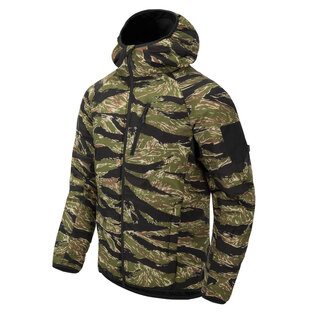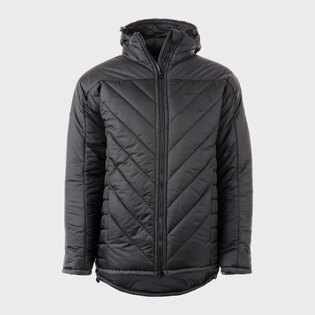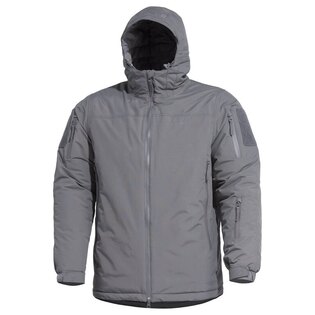Choosing a winter jacket! How to go for sure?
It is possible that some people get goosebumps when they hear the words "buying a winter jacket" and recall unpleasant memories from their childhood. Like sweating endlessly in a cramped changing room in an overheated shop while your mum brings you one awful piece after another. Or picking out a jacket in the market based on whether both sleeves are the same length and there's no cigarette burn anywhere. Or maybe your grandmother gave you a model that not only remembered the time of the Emperor, but also had to fit three sweaters underneath to keep from freezing...
Well, no, we're gonna do it differently this time. We will clarify the basic parameters to consider when choosing a winter jacket, what features and functional elements to expect from a winter jacket, in short, how to make the selection process more efficient so that the chances of getting it wrong are absolutely minimal.
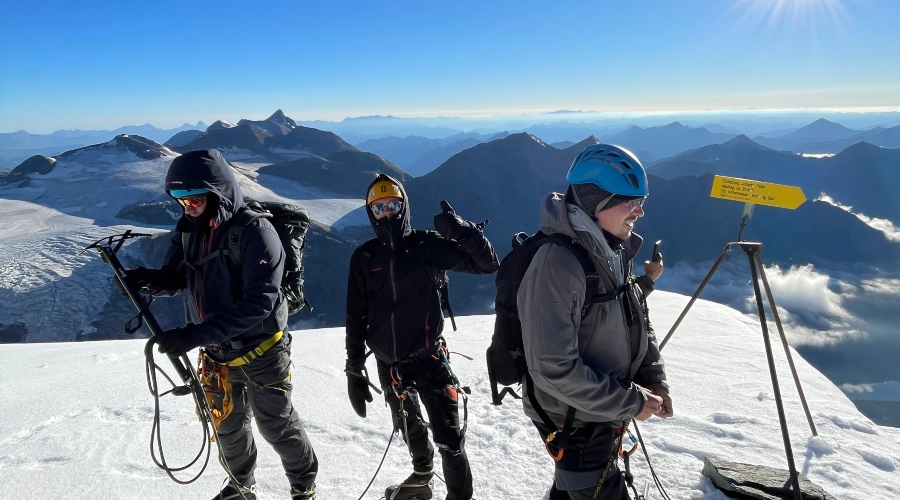
You should also choose a winter jacket according to your planned activities. Are you going to the city, to the shooting range, or do you need it for sports and outdoor activities?
For what activities will you use the jacket?
A jacket for everyday wear in town, at work or walking the dog will meet different criteria than a specialist outdoor jacket. We've already covered what parameters quality winter jackets should have in common. How do they differ from each other?
Jacket for everyday wear
Or a city jacket or a jacket for leisure activities. These jackets tend to be versatile, usually with a sleek and clean design and spacious pockets, where manufacturers count on you to carry your everyday essentials and occasionally warm your hands in them. The main focus is on comfort and they are suitable for undemanding activities. On the other hand, they are not designed for extreme conditions or demanding physical activities where you will sweat a lot and need maximum freedom of movement.
Winter outdoor jacket
The spectrum of winter outdoor jackets is almost as wide as the spectrum of outdoor activities. Therefore, different jackets have different characteristics and parameters. It's also a good idea to decide in advance whether you prefer a single thick and properly insulated jacket or several thinner layers that you can freely combine according to the current conditions - e.g. a down jacket as an additional insulation layer and a light jacket with a membrane (e.g. softshell or Gore-Tex).
Then there are jackets specifically designed for a particular sport. For example, a ski jacket must insulate well, be mechanically resistant and ideally have a helmet-compatible hood, snow belt and pockets for goggles and ski passes. A snowboard jacket will have a looser and longer cut compared to a ski jacket and allow a greater range of movement, otherwise their parameters will be similar. If you prefer freeride to downhill, where you'll be falling or riding buried in powder snow more often, add a higher water column (above 5,000 mm). A cross-country and racing skialp jacket, on the other hand, will be lightweight, breathable and equipped with reflective elements. Special mountaineering jackets must be able to withstand extremely cold temperatures while maintaining maximum range of motion.
And what criteria should an outdoor jacket designed for hiking and longer stays outdoors meet? First of all, waterproofness, windproofness, Breathability and appropriately selected functional elements. We will now talk more about these parameters.
Basic technical parameters
Waterproofness
A waterproof jacket can withstand rain to a certain extent. The water column is a quantity that indicates in millimetres how much water a material can hold. There is a simple proportion - the higher the number, the more waterproof the material is. How can you use this value as a guide?
- Up to 2 000 mm: Clothing with water column values of less than 2 000 mm is not waterproof.
- 5 000 mm: can withstand light to moderate rain. This clothing is suitable for the city or for light hiking and is mostly sufficient for Czech conditions.
- 10 000 mm: can withstand heavy rain, suitable for longer treks.
- 20 000 mm: waterproof clothing.
- 30 000 mm a více: clothing for extreme conditions.
A big influence on the overall water resistance is the processing of the seams, because they are among the weakest links in the jacket. Therefore, they should be taped or otherwise technologically treated to prevent water penetration. Other areas at risk include places where pressure is exerted, such as under the shoulder straps when carrying a heavy backpack. This should be taken into account and a higher water column should be chosen. It is often argued that high water column values are detrimental to Breathability. However, this may no longer be true with modern materials.
Breathability
Breathability is a value that indicates how well clothing "breathes", i.e. how well it wicks moisture away from the body. The higher the breathability, the better. It is measured in two ways:
- MVTR method: indicates how much water one square metre of fabric can absorb in 24 hours. This figure should be as high as possible. Values for normal wear are around 10,000 g/m2/24 h, and even higher for sports jackets. Unless you like to bathe in sweat, don't go below 4,000 g/m2/24 h.
- RET method: is more precise and indicates the resistance of the substance to the passage of water vapour. The RET number should be as low as possible; clothing with a RET of around 6 will provide good breathability, while a fabric with a RET of 20 is no longer breathable.
Windproofness
Strong winds can significantly drop the temperature and, in extreme cases, even affect the success of the event. Wind resistance can be provided by the membrane or the density of the weave.
Thermal insulation
- Feathers: is lighter, easy to pack and has excellent warmth and insulating properties. It is perfect for insulation. However, it absorbs moisture easily, losing its insulating properties (this can be partly prevented by the impregnation and waterproof surface material), dries slowly and is generally more difficult to maintain.
- Synthetics: handles moisture better, is easier to maintain and more affordable. Insulating properties tend to be slightly weaker than those of down, but are comparable with modern materials. Frequent packing and compression will erode the insulation and gradually weaken it.
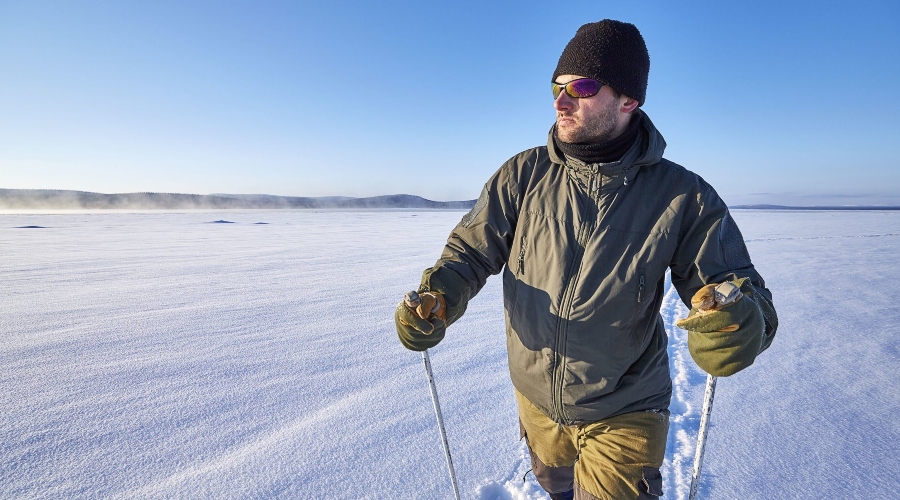
The right winter jacket must provide you with thermal comfort. This requires not only good insulation, but also Breathability and well-chosen functional elements.
Functional elements
Practical functional elements complement the features of the jacket. These include:
- Hood: the advantage is a shaped hood that can be folded or taken off and is compatible with the helmet.
- Pockets: well-placed exterior and interior pockets are practical. However, a large number of pockets can unnecessarily increase the weight of the jacket, while bad workmanship can make it waterproof and windproof. Some pockets may remain covered by other equipment during use, e.g. the waist belt of the backpack. Therefore, always consider which pockets you will actually use and which are extra.
- Construction. The well-designed cut ensures comfort and freedom of movement. The jacket should not bulge too much in the back or sleeve area when bending over or moving the arms. This is helped by the extended back, the jacket's drawcord hem and the cuffs on the sleeves.
- Collar: high collar protects your neck. Of course there is a chin guard, which will not scratch your chin or cut your beard.
- Ventilation holes: help increase breathability and can be found especially in the armpits.
- Quality zippers: like all seals (e.g. seams), zippers are one of the critical points, so they should be of high quality, covered with a flap, ideally YKK, and not jammed. With a double-sided zipper you get better ventilation, but at the same time it is easier to get to the material on your belt when shooting, for example.
TIP: Watch our video on choosing a winter jacket.
Try it on properly
Of course, you can order a winter jacket through the online shop, but it is much better to get to know it "in person" first. How to test it thoroughly in the shop?
- You must like it. You should really like the jacket, otherwise you simply won't be comfortable in it and probably won't wear it.
- Always try a jacket with a sweater or sweatshirt that you will actually wear underneath.
- When deciding between two sizes, go a little bigger (but not too big) rather than a little smaller.
- Zip up the jacket and try different arm movements in full range. It must stay in place, not pull or roll up anywhere.
- Test the zippers several times, in any case they must not get stuck.
Our tips
1. Helikon-Tex Hoodie Wolfhound
Tthis lightly insulated jacket from Helikon-Tex is designed for temperatures around or just above freezing. It can be used as a main jacket or as an additional layer under another waterproof jacket. It differs from other jackets in our offer with an interesting Desert Night Camo camouflage pattern, which was used during the Gulf War as a defense against Soviet-made NVDs. Otherwise, its design is quite simple, clean and unobtrusive. It is also made in a women's version.
This lightweight and compact model is insulated with Climashield Apex insulation. Windpack membrane protects against wind and light rain. Other important features include a high-quality two-way YKK zipper, underarm ventilation and a hood that comfortably hugs the face. There are a total of four pockets, including one inner, one chest and two side pockets filled with comfortable microfleece, one of which houses a compression bag.
TIP: Watch our video about the Helikon-Tex Hoodie Wolfhound.
2. Snugpak Insulated SJ12
Wrapped in a compression sleeve, this jacket will feel like a sleeping bag at first glance and will hold you up in the coldest of cold. It has a comfort temperature of -15 °C and a minimum temperature of -20 °C. The Paratex Micro outer material has a ripstop finish that provides mechanical and wind resistance. The Paratex Lite inner layer, on the other hand, insulates and wicks moisture away from the body. The patented Softie Premier insulation was originally developed for sleeping bags and has excellent thermal properties that are still there even when wet.
The jacket is well constructed. It has an extended cut, but you can "shorten" it by pulling down the hem without losing access to the side pockets. The hood is adjustable, rollable and very comfortable. The sleeves, which have a soft insert inside, are also well detailed. This soft insert wraps comfortably around the arm while preventing heat from escaping. The two outer side pockets are also insulated, and the jacket also has one inner horizontal pocket.
TIP: Watch our video about the Snugpak Insulated SJ12 jacket here.
3. Pentagon Velocity Primaloft Ultra
With a comfort temperature of -15 °C and a minimum temperature of -20 °C, this model won't let you down in freezing temperatures. Although it looks a bit bulky at first glance thanks to the thick layer of insulation, it has an anatomical fit, is very comfortable and ensures freedom of movement. The construction is very well crafted. The water column reaches 5,000 mm, so it won't get wet even in prolonged moderate rain, while maintaining excellent Breathability.
The base of the outer and inner layers is nylon, the outside is more durable, ripstop treated and Storm Tex membrane, while the inside is softer. The filling is high-quality PrimaLoft. There are ventilation holes in the armpits with mesh inside. The sleeves are finished with cuffs, on the bottom of the left sleeve you will find a small zipped pocket with a loop. On the upper parts of both sleeves there are pockets with velcro panels and waterproof zippers. The generously designed fleece-filled side pockets are divided into smaller pockets inside. The adjustable hood with a small visor is also filled with fleece, which makes it extra comfortable.
TIP: A video about the Pentagon Velocity PrimaLoft Ultra jacket can be found here.
Readers are further interested



















































































































